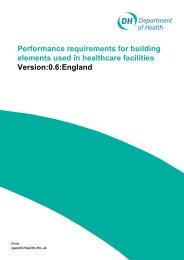Early Life Nutrition and Lifelong Health - Derbyshire Local Medical ...
Early Life Nutrition and Lifelong Health - Derbyshire Local Medical ...
Early Life Nutrition and Lifelong Health - Derbyshire Local Medical ...
You also want an ePaper? Increase the reach of your titles
YUMPU automatically turns print PDFs into web optimized ePapers that Google loves.
BMA Board of ScienceBox 3: Fetal programmingIn this context the term ‘fetal programming’ is widely used. It is somewhat misleading, as itimplies deterministic mechanisms, similar to its original use for the genetic programme fordevelopment. 41 It suggests analogy with a computer programme which, once running, cannotbe altered. There is now more use of the terms programming <strong>and</strong> reprogramming to refer tothe processes by which stem cells become pluripotent during embryonic life. 42 This is in linewith the original use, as it suggests switches between predetermined developmentalpathways, enabling embryonic stem cells to differentiate to lung, liver, lymphocytes, etc. Theuse of ‘fetal programming’ or ‘programming of disease’ is at odds with the plastic nature ofadaptive responses by the embryo, fetus <strong>and</strong> infant <strong>and</strong> also underplays the role of laterenvironment in exacerbating the risk of disease. Developmental origins of disease, or inductionof risk of disease are more accurate terms for this process.The validity of the concept of the developmental origins of disease has been questioned becauseof the wide variability reported among associations between birth weight <strong>and</strong> proxy markers ofdisease such as later blood pressure, 43 however associations are much stronger when the outcomemeasure is clinical disease. 44 Interpretation is also influenced by the recognition that pregnancies inthe historical cohorts occurred when nutrition <strong>and</strong> healthcare were very different from those ofcontemporary developed societies. The lower birth weight individuals in these cohorts, forexample, would be unlikely to include very pre-term or intrauterine growth restriction (IUGR)fetuses, or the higher birth weight group to include fetuses of diabetic mothers. Another criticismhas concerned the size of the associations between indices of the developmental environmentsuch as birth weight <strong>and</strong> later markers of disease. A meta-analysis 40 suggests for example that,even if causal, a large (1kg) increase in birth weight would be associated with only a 10 to 20 percent reduction in adult ischaemic heart disease across the population. This assumes, however, thatbirth weight is the exposure of interest. The hypotheses relating fetal nutrition <strong>and</strong> growth to laterdisease suggest that birth weight, a crude summary of fetal development, is likely to be a distantreflection of the cellular <strong>and</strong> molecular processes affected by intra-uterine environment. For diseasesuch as type 2 diabetes, childhood obesity has a large exacerbating effect. 45Correction for adult BMI is another area which has proved controversial. There is an associationbetween larger size at birth <strong>and</strong> increased adult BMI (itself a strong risk factor for type 2 diabetes<strong>and</strong> cardiovascular disease). Since the associations between size at birth <strong>and</strong> adult diseases are inthe opposite direction, when adjusting these associations for adult BMI the effect of small size atbirth appears stronger. The interpretation of this effect is controversial; it could indicate that anadverse effect of small size at birth is revealed more clearly by removing the influence of adult BMI,or it could indicate that the key insult is the transition from being a small baby to being an obeseadult 46 as in the mismatch concept (see Figure 3). It is impossible to distinguish between these twopossibilities using observational data. The evidence actually suggests that both of these scenariosapply. Many studies have shown adverse effects of small size at birth on adult disease withoutadjustment for BMI (see Figure 4). 47-4916<strong>Early</strong> life nutrition <strong>and</strong> lifelong health



